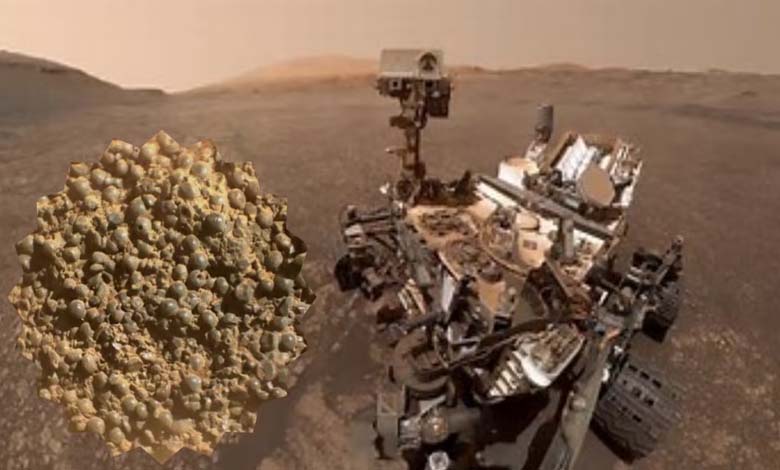The Mysterious Sphere Cluster: A Strange Rock on Mars Puzzles Scientists

A small, brownish rock recently discovered on the surface of Mars has left scientists scratching their heads due to its curious resemblance to a cluster of spider eggs or perhaps a lentil on a leaf. This peculiar formation, captured by NASA’s Perseverance rover, has ignited speculation and intrigue among planetary scientists, as it contains hundreds of small, nearly perfectly spherical objects. Each of these spheres measures only about one millimeter in diameter, creating a striking and puzzling visual. Researchers are now left to decipher the geological origins and nature of this mysterious rock, with many questions remaining unanswered about how it formed.
-
The Secret Behind Mars’ Red Color… Is Water the Cause?
-
Discovery of Billion-Year-Old Seashores on Mars
The discovery has fueled discussions about the possibility of this rock being a relic from Mars’s complex and dynamic volcanic past. Some experts believe that these spherical structures could provide crucial insights into the planet’s ancient history, especially regarding its volcanic activity. With Mars‘s history stretching back approximately 4.6 billion years, scientists are increasingly looking for evidence that could explain the planet’s transformation over the millennia—from a once warmer, potentially habitable world to the cold, desolate environment we see today.
An Unexpected Formation: The Peculiar “Spherules” of Mars
The object in question appears to be a mass composed of “spherules,” small, nearly spherical particles with diameters ranging from 0.01 mm to 4 mm. While most of the spherules appear relatively uniform in shape, some exhibit elongated or oval forms, while others have jagged, angular edges that may suggest they were once part of a larger structure but broke apart over time. The variety in the shapes and sizes of the spherules has added another layer of complexity to understanding their formation.
-
Discovery of an Ancient Ocean Shoreline on Mars
-
Something resembling a human face on Mars… What does it mean?
What adds an additional layer of intrigue to the mystery are the tiny perforations that can be observed on some of the spherules. These minute holes resemble those that would be made by a needle, suggesting the possibility of some form of chemical or physical interaction that caused these formations. Such perforations raise the question of whether they were the result of a natural process like erosion, or whether they could point to a more complex set of interactions involving water, volcanic activity, or even microbial life—though the latter remains an unlikely possibility.
The size and characteristics of these spherules are somewhat similar to a previous discovery made by NASA’s Opportunity rover in 2004. Known as “Mars Blueberries,” these small, spherical objects were found in the Meridiani Planum region and were initially thought to be remnants of small meteorites that had shattered upon entering Mars’s atmosphere. The “blueberries” were believed to have formed through a process involving the interaction of water and minerals, possibly offering a glimpse into the conditions that might have existed on Mars when liquid water was more abundant on its surface.
-
New Surprise from “SpaceX”: 5 Vehicles to Mars
-
For the First Time, Scientists Discover Water Frost on Mars’ Volcanoes
The Volcanic Past of Mars: Could This Rock Be a Product of Ancient Eruptions?
As researchers continue to examine the peculiar rock and its embedded spherules, many are turning their attention to Mars’s volcanic history for clues about its origin. According to NASA, Mars was once home to thousands of massive volcanoes that experienced some of the most colossal eruptions in the solar system’s history. These eruptions would have shaped the surface of Mars and released vast amounts of gases and minerals into the atmosphere, potentially contributing to the formation of unique geological features.
The size of Mars‘s volcanic structures, such as Olympus Mons—the largest volcano in the solar system—suggests that the planet experienced powerful eruptions that may have led to the creation of these strange spherical formations. Volcanic activity on Mars was likely widespread, with eruptions happening over an extended period. This means that the rocks found by Perseverance may represent remnants of ancient volcanic processes, capturing a snapshot of the planet’s turbulent past.
-
The Solar Storm Changes Its Course and Targets Mars
-
Revealing the Origin of Two Billion Craters on the Planet Mars
One hypothesis is that these spherules could have formed as a result of volcanic activity that involved the rapid cooling of molten rock. If this formation process is similar to that of volcanic glass, where minerals crystallize quickly in a cooling environment, the spherules may have been formed by the rapid cooling of molten rock or lava. Alternatively, they could have been produced by the weathering of volcanic deposits over time, which would have caused them to break into smaller, rounded pieces.
Mars’s atmosphere, though thin and mostly carbon dioxide, may have played a role in the formation of these spherules. A process involving the interaction of volcanic gases, minerals, and the thin Martian atmosphere could have facilitated the creation of such distinct, spherical structures. Additionally, ancient water or ice on Mars may have contributed to the chemical weathering of volcanic rock, potentially leading to the formation of spherules as well.
-
Achievements in the Emirates Mars Mission: “Hope Probe” in a Full Martian Year
-
Malfunction Ends “Mars Helicopter” Mission
Scientists React: The Discovery Sparks Fascination and Further Research
The discovery of these strange spherules has led to excited reactions from the scientific community. Alex Jones, a PhD student at Imperial College London, commented on the discovery with palpable enthusiasm: “The Perseverance science team was amazed by a peculiar rock composed of hundreds of millimeter-sized spheres. Placing these formations in their geological context will be crucial to understanding their origin and their significance for the geological history of Jezero Crater and beyond.” Jones emphasized the importance of not only studying the rock itself but also understanding its place in the broader geological history of Mars.
The Jezero Crater, where the Perseverance rover is currently conducting its mission, is believed to have once contained an ancient lake. Scientists are keen to understand how this region, which may have harbored water in the distant past, might have influenced the rock formations found there. It is possible that the spherules discovered by Perseverance were influenced by the presence of liquid water, volcanic activity, or both, making them a critical piece in the puzzle of Mars‘s early environmental conditions.
As more data is collected and analyzed, scientists are hopeful that they can place these findings in the proper geological context. Understanding how these spheres formed could reveal more about Mars‘s ancient climate, its volcanic activity, and its potential for past habitability.
The Significance of Mars’s Geological History: Unlocking the Secrets of the Red Planet
The study of Mars’s geological history is a central focus of NASA’s ongoing exploration missions, and each new discovery adds to our understanding of the planet’s past. The spherules found by Perseverance are just the latest in a series of intriguing discoveries that are shedding light on Mars’s ancient environment. Whether they were formed by volcanic activity, water interactions, or another process, these small spheres could provide invaluable information about the conditions on Mars when it was potentially more hospitable to life.
-
“NASA” reveals the latest images of Mars… a breathtaking scene
-
Smart chemical robot may produce oxygen on Mars
NASA’s goal is to continue unraveling the mysteries of Mars through its rovers, orbiters, and future sample-return missions. In doing so, the space agency hopes to better understand the planet’s geological past and evaluate its potential to support life, both in the ancient past and, potentially, in the future. The discovery of the spherules is yet another step forward in this ongoing journey, offering a tantalizing glimpse into the Red Planet’s complex history.
A Glimpse into Mars’s Future Exploration: What’s Next for Perseverance?
The Perseverance rover, which has been on Mars since February 2021, is equipped with a sophisticated array of scientific tools designed to analyze the planet’s surface in unprecedented detail. As the rover continues to explore Jezero Crater and beyond, it will undoubtedly uncover more geological features that will deepen our understanding of Mars’s evolution. Future missions, including those designed to collect samples from the Martian surface and return them to Earth, will provide even greater opportunities to study rocks and soil up close.
-
Discovery of the source of a giant earthquake that hit Mars… The reason is shocking
-
Scientists: NASA Found Alien Life on Mars 50 Years Ago
In the coming years, NASA plans to launch additional missions aimed at uncovering more secrets about the planet’s history and its potential for past or present life. The Perseverance rover’s findings, including the discovery of these enigmatic spherules, will likely play a key role in shaping future exploration strategies. As scientists continue to piece together the geological puzzle of Mars, we can expect more groundbreaking discoveries that will continue to captivate the world and expand our knowledge of the universe.
-
NASA Killed Life on Mars”.. Space Scientist Reveals Surprise
-
Big discovery… NASA confirms the existence of water on Mars!












